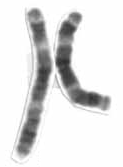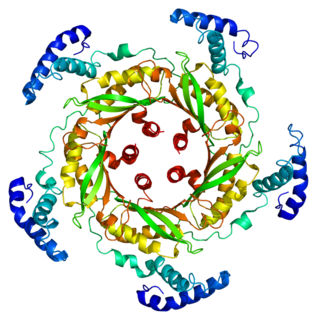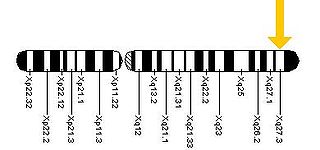Related Research Articles

Essential tremor (ET), also called benign tremor, familial tremor, and idiopathic tremor, is a medical condition characterized by involuntary rhythmic contractions and relaxations of certain muscle groups in one or more body parts of unknown cause. It typically is symmetrical, and affects the arms, hands, or fingers; but sometimes involves the head, vocal cords, or other body parts. Essential tremor is either an action (intention) tremor—it intensifies when one tries to use the affected muscles during voluntary movements such as eating and writing—or it is a postural tremor, present with sustained muscle tone. This means that it is distinct from a resting tremor, such as that caused by Parkinson's disease, which is not correlated with movement.

A tremor is an involuntary, somewhat rhythmic, muscle contraction and relaxation involving oscillations or twitching movements of one or more body parts. It is the most common of all involuntary movements and can affect the hands, arms, eyes, face, head, vocal folds, trunk, and legs. Most tremors occur in the hands. In some people, a tremor is a symptom of another neurological disorder. A very common tremor is the teeth chattering, usually induced by cold temperatures or by fear.

Parkinsonism is a clinical syndrome characterized by tremor, bradykinesia, rigidity, and postural instability. These are the four motor symptoms found in Parkinson's disease (PD), after which it is named, dementia with Lewy bodies (DLB), Parkinson's disease dementia (PDD), and many other conditions. A wide range of causes may lead to this set of symptoms, including neurodegenerative conditions, drugs, toxins, metabolic diseases, and neurological conditions other than PD.

Tremors is a 1990 American horror comedy film directed by Ron Underwood, produced by Gale Anne Hurd, Brent Maddock, and S. S. Wilson, and written by Maddock, Wilson, and Underwood. Tremors was released by Universal Pictures and stars Kevin Bacon, Fred Ward, Finn Carter, Michael Gross, and Reba McEntire.

Hyperkinesia refers to an increase in muscular activity that can result in excessive abnormal movements, excessive normal movements or a combination of both. Hyperkinesia is a state of excessive restlessness which is featured in a large variety of disorders that affect the ability to control motor movement, such as Huntington's disease. It is the opposite of hypokinesia, which refers to decreased bodily movement, as commonly manifested in Parkinson's disease.
A thalamic stimulator is a relatively new medical device that can suppress tremors, such as those caused by Parkinson's disease or essential tremor. It was approved for use by the Food and Drug Administration (FDA) on August 4, 1997. Installation is invasive, so it is typically only used when the tremors are incapacitating, and medication is ineffective. Typically, one or more electrodes are implanted in the brain, with subcutaneous leads to a neurostimulator, which may also be implanted. The electrodes stimulate the area of the thalamus, specifically the part of the brain that controls movement and muscle function.

Chromosome 3 is one of the 23 pairs of chromosomes in humans. People normally have two copies of this chromosome. Chromosome 3 spans almost 200 million base pairs and represents about 6.5 percent of the total DNA in cells.
Intention tremor is a dyskinetic disorder characterized by a broad, coarse, and low frequency tremor. The amplitude of an intention tremor increases as an extremity approaches the endpoint of deliberate and visually guided movement. An intention tremor is usually perpendicular to the direction of movement. When experiencing an intention tremor, one often overshoots or undershoots one's target, a condition known as dysmetria. Intention tremor is the result of dysfunction of the cerebellum, particularly on the same side as the tremor in the lateral zone, which controls visually guided movements. Depending on the location of cerebellar damage, these tremors can be either unilateral or bilateral.

GTP cyclohydrolase I (GTPCH) (EC 3.5.4.16) is a member of the GTP cyclohydrolase family of enzymes. GTPCH is part of the folate and biopterin biosynthesis pathways. It is responsible for the hydrolysis of guanosine triphosphate (GTP) to form 7,8-dihydroneopterin triphosphate (7,8-DHNP-3'-TP, 7,8-NH2-3'-TP).

The ventral posterior nucleus is the somato-sensory relay nucleus in thalamus of the brain.
ETM2 is a gene associated with essential tremor.

Homeobox protein CDX-2 is a protein that in humans is encoded by the CDX2 gene. The CDX2 protein is a homeobox transcription factor expressed in the nuclei of intestinal epithelial cells, playing an essential role in the development and function of the digestive system. CDX2 part of the ParaHox gene cluster, a group of three highly conserved developmental genes present in most vertebrate species. Together with CDX1 and CDX4, CDX2 is one of three caudal-related genes in the human genome.

Homeobox protein Nkx-2.5 is a protein that in humans is encoded by the NKX2.5 gene.

A neurological disorder is any disorder of the nervous system. Structural, biochemical or electrical abnormalities in the brain, spinal cord or other nerves can result in a range of symptoms. Examples of symptoms include paralysis, muscle weakness, poor coordination, loss of sensation, seizures, confusion, pain and altered levels of consciousness. There are many recognized neurological disorders, some relatively common, but many rare. They may be assessed by neurological examination, and studied and treated within the specialities of neurology and clinical neuropsychology.

Myoclonic dystonia or Myoclonus dystonia syndrome is a rare movement disorder that induces spontaneous muscle contraction causing abnormal posture. The prevalence of myoclonus dystonia has not been reported, however, this disorder falls under the umbrella of movement disorders which affect thousands worldwide. Myoclonus dystonia results from mutations in the SGCE gene coding for an integral membrane protein found in both neurons and muscle fibers. Those suffering from this disease exhibit symptoms of rapid, jerky movements of the upper limbs (myoclonus), as well as distortion of the body's orientation due to simultaneous activation of agonist and antagonist muscles (dystonia).

Fragile X-associated tremor/ataxia syndrome (FXTAS) is a late-onset neurodegenerative disorder most frequently seen in male premutation carriers of Fragile X syndrome (FXS) over the age of 50. The main clinical features of FXTAS include problems of movement with cerebellar gait ataxia and action tremor. Associated features include parkinsonism, cognitive decline, and dysfunction of the autonomic nervous system. FXTAS is found in Fragile X "premutation" carriers, which is defined as a trinucleotide repeat expansion of 55-200 CGG repeats in the Fragile X mental retardation-1 (FMR1) gene. 4-40 CGG repeats in this gene is considered normal, while individual with >200 repeats have full Fragile X Syndrome.
HCLS1 binding protein 3 also known as HS1BP3 is a protein which in humans is encoded by the HS1BP3 gene.

Polyphosphoinositide phosphatase also known as phosphatidylinositol 3,5-bisphosphate 5-phosphatase or SAC domain-containing protein 3 (Sac3) is an enzyme that in humans is encoded by the FIG4 gene. Fig4 is an abbreviation for Factor-Induced Gene.

1-Octanol, also known as octan-1-ol, is the organic compound with the molecular formula CH3(CH2)7OH. It is a fatty alcohol. Many other isomers are also known generically as octanols. 1-Octanol is manufactured for the synthesis of esters for use in perfumes and flavorings. It has a pungent odor. Esters of octanol, such as octyl acetate, occur as components of essential oils. It is used to evaluate the lipophilicity of pharmaceutical products.

Lolitrem B is one of many toxins produced by a fungus called Epichloë festucae, which grows in perennial ryegrass. The fungus is symbiotic with the ryegrass; it doesn't harm the plant, and the toxins it produces kill insects that feed on ryegrass. Lolitrem B is one of these toxins, but it is also harmful to mammals. The shoots and flowers of infected ryegrass have especially high concentrations of lolitrem B, and when livestock eat too much of them, they get perennial ryegrass staggers. At low doses the animals have tremors, and at higher doses they stagger, and at higher yet doses the animals become paralyzed and die. The blood pressure of the animals also goes up. The effect of the lolitrem B comes on slowly and fades out slowly, as it is stored in fat after the ryegrass is eaten. The condition is especially common in New Zealand and Australia, and plant breeders there have been trying to develop strains of fungus that produce toxins only harmful to pests, and not to mammals.
References
| This article on a gene on human chromosome 3 is a stub. You can help Wikipedia by expanding it. |